Quick Look
Grade Level: 5 (3-5)
Time Required: 30 minutes
Lesson Dependency: None
Subject Areas: Earth and Space
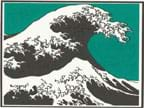
Summary
Students learn about tsunamis, discovering what causes them and what makes them so dangerous. They learn that engineers design detection and warning equipment, as well as structures that that can survive the strong wave forces. In a hands-on activity, students use a table-top-sized tsunami generator to observe the formation and devastation of a tsunami. They see how a tsunami moves across the ocean and what happens when it reaches a coastline. They make villages of model houses to test how different material types are impacted by the huge waves.Engineering Connection
Engineers use their creativity to save lives and decrease the destruction caused by tsunamis. While tsunamis cannot be prevented, engineers can design monitoring equipment to help scientists gather data to detect them early so people can be warned and evacuated to safety. Cameras continually watch volcanoes, seismometers measure tremors, GPS receivers measure mountain swelling, pressure sensors monitor air waves caused by explosions, and radar and satellites communicate the height, size and location of ash plumes. Some engineers design structures that can survive tsunamis. Other engineers design warning systems such as harbor disaster sirens, automated news media bulletins and emergency communication centers.
Learning Objectives
After this lesson, students should be able to:
- Describe a tsunami as a large wave that is caused by the movement of the sea floor.
- List some causes of tsunamis, including earthquakes, volcanoes and landslides.
- Relate that engineers use special sensors to detect tsunamis.
- Explain how engineers are working to create buildings that can survive tsunamis.
Educational Standards
Each TeachEngineering lesson or activity is correlated to one or more K-12 science,
technology, engineering or math (STEM) educational standards.
All 100,000+ K-12 STEM standards covered in TeachEngineering are collected, maintained and packaged by the Achievement Standards Network (ASN),
a project of D2L (www.achievementstandards.org).
In the ASN, standards are hierarchically structured: first by source; e.g., by state; within source by type; e.g., science or mathematics;
within type by subtype, then by grade, etc.
Each TeachEngineering lesson or activity is correlated to one or more K-12 science, technology, engineering or math (STEM) educational standards.
All 100,000+ K-12 STEM standards covered in TeachEngineering are collected, maintained and packaged by the Achievement Standards Network (ASN), a project of D2L (www.achievementstandards.org).
In the ASN, standards are hierarchically structured: first by source; e.g., by state; within source by type; e.g., science or mathematics; within type by subtype, then by grade, etc.
NGSS: Next Generation Science Standards - Science
-
CCC.8.3-5.8.
Engineers improve existing technologies or develop new ones to increase their benefits, to decrease known risks, and to meet societal demands.
(Grades 3 - 5)
More Details
Do you agree with this alignment?
-
DCI.ESS3.B.3-5.3.
A variety of hazards result from natural processes (e.g., earthquakes, tsunamis, volcanic eruptions). Humans cannot eliminate the hazards but can take steps to reduce their impacts.
(Grade 4)
More Details
Do you agree with this alignment?
-
SEP.11.2.
Science explanations describe the mechanisms for natural events.
(Grade 5)
More Details
Do you agree with this alignment?
State Standards
Colorado - Science
-
Develop and communicate an evidence based scientific explanation around one or more factors that change Earth's surface
(Grade
5)
More Details
Do you agree with this alignment?
Pre-Req Knowledge
A familiarity with the concepts of tectonic plates, earthquakes, volcanoes and landslides.
Introduction/Motivation
Do you know what a tsunami is? Do you know how a tsunami is formed or where tsunamis usually strike? A tsunami is a special kind of wave, but what is it that makes it different from a normal wave? The difference is that an average wave is just a surface disturbance of the water, while a tsunami is a disturbance that reaches all the way to the bottom of the body of water (in the case of a tsunami this is usually an ocean or a sea). A tsunami is a really large wave. In fact, a tsunami can be a wave that reaches more than 300 meters (1,000 feet) high!
Classroom demonstration:
To demonstrate the difference in waves, use a clear bowl of water. Blow across the surface of the water and ask students notice the waves that form. Next, quickly pour a large cup of sand or pebbles into the water at one end of the bowl. Have the students compare the waves. Are they the same size? The wave caused by the sand created a larger wave because the sand disturbed (moved) a lot more water than the wind. In the ocean, no matter how hard the wind blows, it cannot disturb water more than a few meters below the surface. An earthquake, an underwater landslide (much like our cup of sand) or a volcano each has the power to disturb the water all the way from the surface to the sea floor. Basically, a tsunami occurs when something moves the sea floor. Tsunamis are typically larger and more destructive than a normal wave caused by wind.
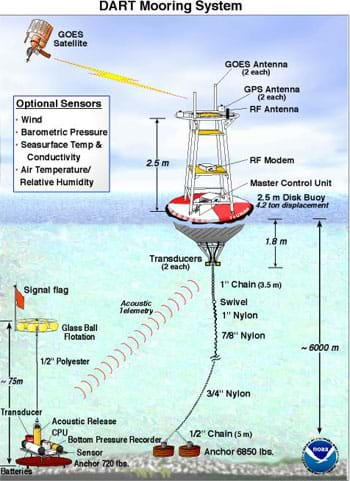
Since tsunamis can be so deadly, scientists and engineers have developed ways to detect them before they reach the coast so that people can be warned. The U.S. west coast is monitored by the National Oceanic and Atmospheric Administration's (NOAA) Deep-Ocean Assessment and Reporting of Tsunamis (DART) system. The DART system consists of a bottom pressure recorder (BPR) — a sensor — that sits on the bottom of the ocean and detects small pressure increases that indicate that a tsunami has passed over. The BPR communicates the data it collects to a buoy floating on the surface. The buoy relays the information to a satellite that transmits the data to tsunami warning centers (see Figure 1).
Since tsunamis can only be detected and not prevented, engineers are designing structures that can survive the destructive forces of a tsunami. When designing a building to survive a tsunami, engineers consider where the house is, how it is oriented, what it is made of, and its shape. For example, a group of engineers from MIT and Harvard universities worked with the Buro Happold engineering firm in England to design a house that would be more likely to survive a tsunami. They came up with a design that allowed the tsunami to flow through and under the house. This kept the energy of the wave from knocking the house over. The engineers also decided to construct much of the house from cinder blocks, which are considerably stronger than the wood usually used to build homes near coasts. As engineers become more aware of how tsunamis work, they are better prepared to create new tsunami-resistant structures, as well as new devices for detecting tsunamis that can save many lives when the next tsunami strikes. Following the lesson, students can take on the role of engineer as they examine the powerful simulated waves of a tsunami and design to prevent catastrophe with the associated activity Survive That Tsunami! Testing Model Villages in Big Waves.
Lesson Background and Concepts for Teachers
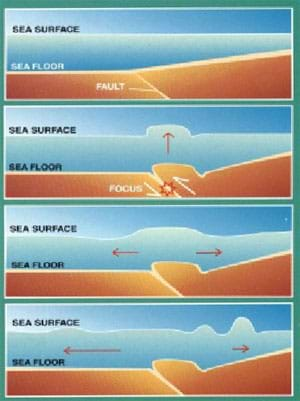
The waves we typically see in oceans, lakes and other bodies of water are usually formed by wind. These waves are just disturbances of the surface and do not extend more than a few meters underwater. Tsunamis differ from normal waves in that they are disturbances that stretch all the way to the floor of the ocean, which can be many kilometers deep.
What Causes a Tsunami?
A tsunami is formed when the sea floor moves abruptly. This is usually caused by an earthquake, but can also be caused by volcanoes and landslides.
Tsunamis resulting from earthquakes are formed when the sea floor moves violently upward as tectonic plates slide against each other (see Figure 2). The sea floor moving upward pushes the water above it upward. This causes a ripple that spreads out from the epicenter in much the same way that the ripples spread out from a pebble thrown into a pond. This ripple is typically no more than a meter high and is barely noticeable to someone in a boat. The speed of the tsunami depends on the depth of the ocean, but typically they move at about 800 kph (500 mph).
Show students an excellent animation showing tsunami formation at the NOAA website: http://www.tsunami.noaa.gov/animations/tsunami_genesis.avi.
Show students an animation showing a simulation of the December 2004 tsunami at: http://www.pmel.noaa.gov/tsunami/Mov/TITOV-INDO2004.mov.
As the tsunami gets closer to land, the depth of the water decreases so the energy from the wave gets compressed. This causes the wave to slow down and increase in height (see Figure 2). By the time the tsunami reaches shore, it has slowed from 800 kph (500 mph) to about 48 kph (30 mph). As the wave hits the coast, it usually does not come in as a smooth wave like the ones you see surfers ride. Tsunamis typically form a bore along the front edge. A bore is a violently churning mass of water. Behind the bore is a large swell of water that floods the coastline.
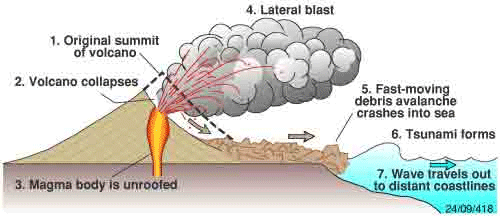
Besides earthquakes, tsunamis can also be caused by volcanoes and landslides. Tsunamis resulting from volcanoes occur when the volcano is either near an ocean or under the surface of one. The tsunami forms when debris, lava or a pyroclastic flow from the volcano displaces the water (see Figure 3).
Underwater landslides also cause tsunamis. When a large chunk of land shifts underwater, some of the water is pushed up, and some is pulled down. This creates a ripple in the water that becomes a tsunami.
Most tsunamis go unnoticed; only those that kill lots of people gain public attention. For example, during the past 100 years, there have been more than 200 tsunamis in the Pacific Ocean alone. See Table 1 for a list of notable Tsunamis from the last 200 years.
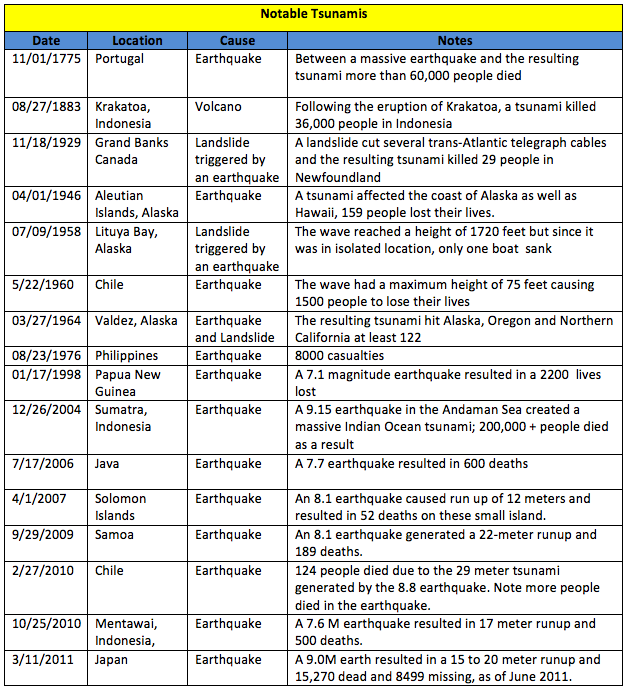
Associated Activities
- Survive That Tsunami! Testing Model Villages in Big Waves - Using a small-scale model to generate waves, students investigate how a tsunami moves. They test structures made from different materials to see how they are affected by the tsunami forces, and discuss how engineers design buildings to survive the huge waves.
Lesson Closure
Today, we learned about tsunamis. What is a tsunami and how it is different from a normal wave? (Answer: Students should realize that a tsunami is a disturbance that reaches all the way to the ocean floor and has a lot more energy than a normal surface wave.) What are the three main causes of tsunamis? (Answer: Earthquakes, volcanoes and landslides.) How does each of these create a tsunami? (Answer: In different ways, they each move the sea floor.) What role do engineers play in detecting tsunamis and protecting homes from them? (Answer: Engineers develop special sensors to detect tsunamis, and they create buildings that can survive the strong forces of a tsunami.) Conduct the summary assessment activities in the Assessment section.
Vocabulary/Definitions
bore: The violently churning front edge of a tsunami.
buoy: A float moored in water to mark a location, warn of danger, indicate a navigational channel or signal information.
detect: To discover the existence, presence or fact of.
energy: The capacity for work or vigorous activity; power.
pyroclastic flow: A hot, dry, fast-moving, and high-density mixture of ash, pumice, rock fragments, and gas that formed during explosive eruptions or from the collapse of a lava dome.
sea floor: (or ocean floor) The bottom of a sea or ocean.
sensor: A device that receives and responds to a signal or stimulus.
tectonic plate: A piece of the Earth's crust that slides over the molten rock of the mantle. As the plates rub against each other earthquakes result that potentially cause tsunamis.
tsunami: A large sea wave of local or distant origin that results from large-scale sea floor displacements associated with large earthquakes, major submarine slides or exploding volcanic islands.
wave: The up and down movement of water.
Assessment
Pre-Lesson Assessment
Know / Want to Know / Learn (KWL) Chart: Before the lesson, ask students to write down in the top left corner of a piece of paper (or as a group on the board) under the title, Know, all the things they know about tsunamis. Next, in the top right corner under the title, Want to Know, ask students to write down anything they want to know about tsunamis. After the lesson, ask students to list in the bottom half of the page under the title, Learned, all of the things that they have learned about tsunamis. Ask students to name a few items and write them on the board.
Discussion Questions: Get students to think about the upcoming lesson by asking them a few discussion questions. After soliciting answers, explain that these questions will be answered during the lesson.
- What is a tsunami?
- What causes a tsunami?
- Can you name any recent tsunamis?
Post-Introduction Assessment
Voting: Ask a true/false question and have students vote by holding thumbs up for true and thumbs down for false. Tally the votes and write the totals on the board. Give the right answer.
- True or False: Tsunamis are formed by wind. (Answer: False. Tsunamis are formed by displacements/movement in the sea floor.)
- True or False: A tsunami is usually larger than a regular wave. (Answer: True)
How high are Tsunamis? In the introduction we said a tsunami could reach more than 300 meters (1,000 feet) high! How tall is this? Have the students measure their height and calculate how many of them stacked on top of each other it would take to reach 1,000 ft. For example, if a student is 4 feet tall, it would take 1000/4 = 250 of them stacked on top of each other to be as tall as a tsunami!
Lesson Summary Assessment
KWL Chart (Conclusion): As a class, finish column L of the KWL Chart as described in the Pre-Lesson Assessment section. List all of the things they learned about tsunamis. Were all of the W questions answered? What new things did they learn?
Drawing: Have students share their subject knowledge gained by drawing a picture. Have the students come up to the board and draw how an earthquake, volcano and landslide might cause a tsunami.
Summary Survey: As you ask aloud the following questions to the entire class, have students write down their answers on their own papers:
- What is a tsunami? (Answer: A huge wave; it moves water all the way to the ocean floor.)
- What causes a tsunami? (Answer: A violent movement of the sea floor, usually due to earthquakes, volcanoes and landslides.)
- Can you name any recent tsunamis? (Answer: See Table 1.)
- What do engineers design to help us detect tsunamis? (Answers: Monitoring and data gathering equipment such as volcano sensors, cameras, seismographs, GPS receivers, pressure sensors, air wave sensors, radar and satellites, etc.)
- What do engineers design to help provide warnings of tsunamis? (Answers: Disaster sirens for beaches and towns; evacuation alarms; automated radio, TV and telephone bulletins; satellite communication; emergency communication centers; etc.)
- What do engineers design to prevent damage from tsunamis? (Answers: They design buildings and structures that can better survive the strong forces of a tsunami. This might include using stronger materials, raising them on stilts or shaping them so water flows around them.)
Lesson Extension Activities
Have students research tsunamis caused by meteors. Also, have them look for other causes for tsunamis.
How scared should we be? Help students put the threat of tsunamis (or any natural disaster) in perspective. For most people, even though the potential damage and loss of life is catastrophic, the probability of encountering a tsunami is very low. Due to 24/7 Internet and news coverage, mass destruction by powerful forces has become more vivid and real to millions of people. Following disasters, there is hyper-alertness to the possibility of another disaster. Then, after some time, our memories fade and we forget. Do repeated warnings stir up unnecessary fear? When does precaution cross the line into paranoia? Is hysteria among a few an unavoidable consequence of informing the many? What are the most likely threats where we live? What can we do to increase our safety?
Subscribe
Get the inside scoop on all things TeachEngineering such as new site features, curriculum updates, video releases, and more by signing up for our newsletter!More Curriculum Like This

Students learn about various natural hazards and specific methods engineers use to prevent these hazards from becoming natural disasters. They study a hypothetical map of an area covered with natural hazards and decide where to place natural disaster prevention devices by applying their critical thi...

Students are introduced to natural disasters and learn the difference between natural hazards and natural disasters.

Students use a table-top-sized tsunami generator to observe the formation and devastation of a tsunami. Students make villages of model houses and buildings to test how different material types are impacted by the huge waves.

This lesson introduces the concepts of wavelength and amplitude in transverse waves. In the associated activity, students use ropes and their bodies to investigate different wavelengths and amplitudes.
References
Dictionary.com. Lexico Publishing Group, LLC. Accessed March 1, 2006. (Source of some vocabulary definitions, with some adaptation) http://www.dictionary.com
Elliott, Laura. Landslides and Hawaii. Posted February 2003. Science Writing Core 1, California Institute of Technology. Accessed April 20, 2006. (See Figure 11 for a good diagram of how a landslide can start a tsunami) http://www.imss.caltech.edu/
ITIC, International Tsunami Information Centre. Updated January 17, 2006. U.S. National Weather Service, NOAA. Accessed March 1, 2006. http://www.tsunamiwave.info/
Tsunami Safe(r) House: A Design for the Prajnopaya Foundation. 2005. SENSEable City Laboratory, Massachusetts Institute of Technology. Cambridge, MA. Accessed March 1, 2006. http://senseable.mit.edu/tsunami-prajnopaya/
NOAA Tsunami Website. 2005. National Oceanic and Atmospheric Administration. Accessed March 1, 2006. http://www.tsunami.noaa.gov
Copyright
© 2006 by Regents of the University of ColoradoContributors
Geoffrey Hill; Malinda Schaefer Zarske; Denise W. CarlsonSupporting Program
Integrated Teaching and Learning Program, College of Engineering, University of Colorado BoulderAcknowledgements
The contents of this digital library curriculum were developed under a grant from the Fund for the Improvement of Postsecondary Education (FIPSE), U.S. Department of Education and National Science Foundation GK-12 grant no. 0338326. However, these contents do not necessarily represent the policies of the Department of Education or National Science Foundation, and you should not assume endorsement by the federal government.
Last modified: April 23, 2022









User Comments & Tips